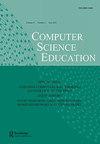Building a gender-inclusive secondary computer science program: teacher led and stakeholder supported
IF 2.2
Q1 EDUCATION & EDUCATIONAL RESEARCH
引用次数: 2
Abstract
ABSTRACT Background Despite ongoing calls for prioritizing K-12 computer science (CS) education, an enduring gender gap exists. Objective We explored one high school CS program where female participation was consistently higher than state averages to better understand how the program was developed. Method Using a case study method, data were collected over three-months through interviews, observations, course documents, student reflections, and researcher reflections. Constant comparative analysis was employed to analyze data throughout and following data generation. Findings Recruitment and teacher support were key practices. Recruitment practices included letter writing campaigns and recruiting from introductory CS courses. Teacher support came from counselors, administrators, and other teachers. While the CS program was consistently more gender-inclusive, the focus when building the program had been on supporting all students, not only female students. Implications Recruitment should be active and purposeful, but using academic indicators for targeted recruitment campaigns can limit student exposure. Teachers need support for broadening participation, particularly from counselors and administrators, who must also be aware of what CS is and their role in these efforts. Opportunities for coteaching within CS programs can be beneficial for growth. Overall, broadening participation must be a holistic effort, supported by school-wide stakeholders, not only CS teachers.建立一个包容性别的中学计算机科学项目:由教师主导,利益相关者支持
背景尽管一直呼吁优先考虑K-12计算机科学(CS)教育,但存在持久的性别差距。我们对一所高中的CS项目进行了研究,该项目的女性参与率一直高于该州的平均水平,以更好地了解该项目是如何发展的。方法采用个案研究法,在三个多月的时间里,通过访谈、观察、课程资料、学生意见和研究者意见收集资料。采用持续比较分析法对数据生成前后的数据进行分析。结果招聘和教师支持是关键措施。招聘活动包括写信活动和从计算机科学入门课程中招聘。教师的支持来自辅导员、管理人员和其他教师。虽然计算机科学项目一直更加性别包容,但在建立该项目时,重点是支持所有学生,而不仅仅是女学生。招聘应该是积极的和有目的的,但使用学术指标有针对性的招聘活动可能会限制学生的曝光。教师需要支持以扩大参与,特别是来自辅导员和管理人员的支持,他们也必须意识到CS是什么以及他们在这些努力中的作用。在计算机科学项目中共同教学的机会对成长是有益的。总的来说,扩大参与必须是一项全面的努力,得到全校利益相关者的支持,而不仅仅是计算机科学教师。
本文章由计算机程序翻译,如有差异,请以英文原文为准。
求助全文
约1分钟内获得全文
求助全文
来源期刊

Computer Science Education
EDUCATION & EDUCATIONAL RESEARCH-
CiteScore
6.90
自引率
3.70%
发文量
23
期刊介绍:
Computer Science Education publishes high-quality papers with a specific focus on teaching and learning within the computing discipline. The journal seeks novel contributions that are accessible and of interest to researchers and practitioners alike. We invite work with learners of all ages and across both classroom and out-of-classroom learning contexts.
 求助内容:
求助内容: 应助结果提醒方式:
应助结果提醒方式:


